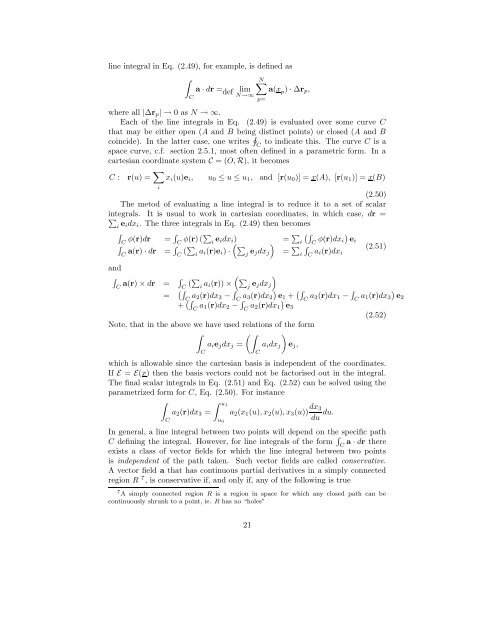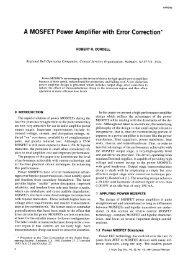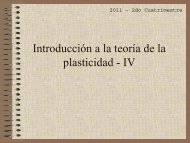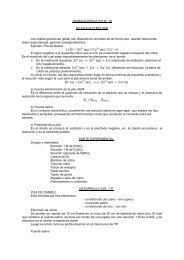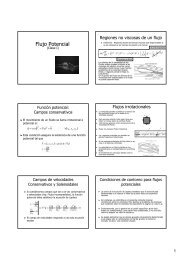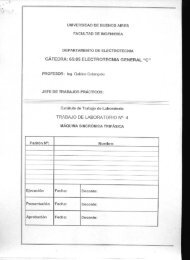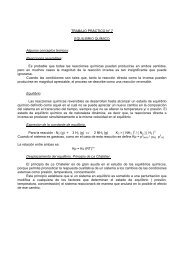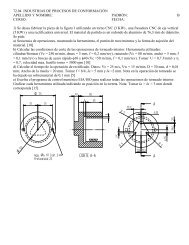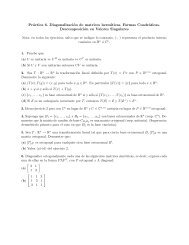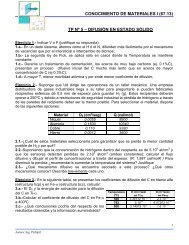Introduction to vector and tensor analysis
Introduction to vector and tensor analysis
Introduction to vector and tensor analysis
Create successful ePaper yourself
Turn your PDF publications into a flip-book with our unique Google optimized e-Paper software.
line integral in Eq. (2.49), for example, is defined as<br />
<br />
C<br />
a · dr = def lim<br />
N→∞<br />
N<br />
a(xp ) · ∆rp,<br />
where all |∆rp| → 0 as N → ∞.<br />
Each of the line integrals in Eq. (2.49) is evaluated over some curve C<br />
that may be either open (A <strong>and</strong> B being distinct points) or closed (A <strong>and</strong> B<br />
coincide). In the latter case, one writes <br />
p=<br />
C<br />
<strong>to</strong> indicate this. The curve C is a<br />
space curve, c.f. section 2.5.1, most often defined in a parametric form. In a<br />
cartesian coordinate system C = (O, R), it becomes<br />
C : r(u) = <br />
xi(u)ei, u0 ≤ u ≤ u1, <strong>and</strong> [r(u0)] = x(A), [r(u1)] = x(B)<br />
i<br />
(2.50)<br />
The me<strong>to</strong>d of evaluating a line integral is <strong>to</strong> reduce it <strong>to</strong> a set of scalar<br />
<br />
integrals. It is usual <strong>to</strong> work in cartesian coordinates, in which case, dr =<br />
i eidxi. The three integrals in Eq. (2.49) then becomes<br />
<br />
<br />
C<br />
C<br />
<br />
φ(r)dr = C φ(r) (i<br />
eidxi) = <br />
i C φ(r)dxi<br />
<br />
a(r) · dr = j ejdxj<br />
<br />
= <br />
i C ai(r)dxi<br />
C (<br />
i ai(r)ei) ·<br />
ei<br />
(2.51)<br />
<strong>and</strong><br />
<br />
a(r) × dr C =<br />
<br />
C (i<br />
ai(r))<br />
× j ejdxj<br />
=<br />
<br />
<br />
C a2(r)dx3 − <br />
C a3(r)dx2<br />
<br />
e1 + <br />
C a3(r)dx1 − <br />
C a1(r)dx3<br />
+ <br />
C a1(r)dx2 − <br />
C a2(r)dx1<br />
<br />
e3<br />
(2.52)<br />
Note, that in the above we have used relations of the form<br />
<br />
<br />
aiejdxj = aidxj ej,<br />
C<br />
which is allowable since the cartesian basis is independent of the coordinates.<br />
If E = E(x) then the basis vec<strong>to</strong>rs could not be fac<strong>to</strong>rised out in the integral.<br />
The final scalar integrals in Eq. (2.51) <strong>and</strong> Eq. (2.52) can be solved using the<br />
parametrized form for C, Eq. (2.50). For instance<br />
<br />
C<br />
u1<br />
a2(r)dx3 =<br />
u0<br />
C<br />
a2(x1(u), x2(u), x3(u)) dx3<br />
du du.<br />
In general, a line integral between two points will depend on the specific path<br />
C defining the integral. However, for line integrals of the form <br />
C a · dr there<br />
exists a class of vec<strong>to</strong>r fields for which the line integral between two points<br />
is independent of the path taken. Such vec<strong>to</strong>r fields are called conservative.<br />
A vec<strong>to</strong>r field a that has continuous partial derivatives in a simply connected<br />
region R 7 , is conservative if, <strong>and</strong> only if, any of the following is true<br />
7 A simply connected region R is a region in space for which any closed path can be<br />
continuously shrunk <strong>to</strong> a point, ie. R has no “holes”<br />
21<br />
e2


